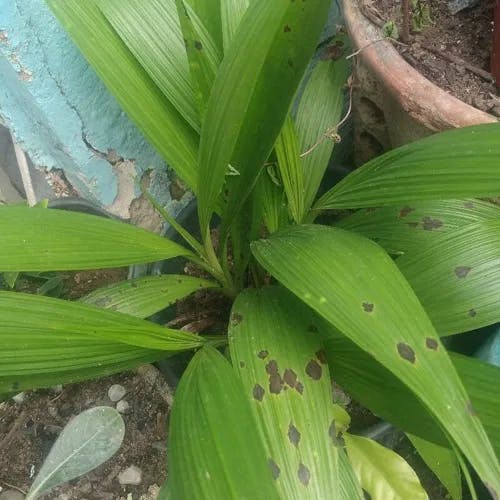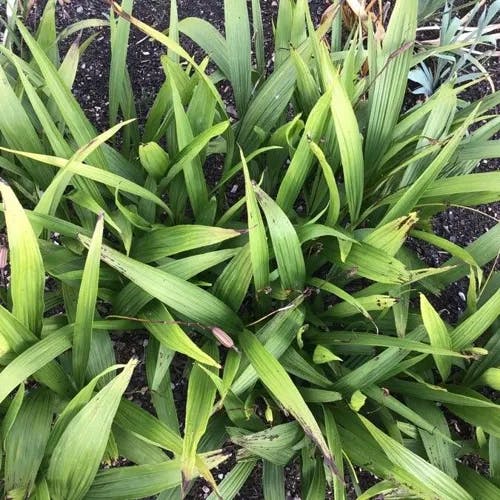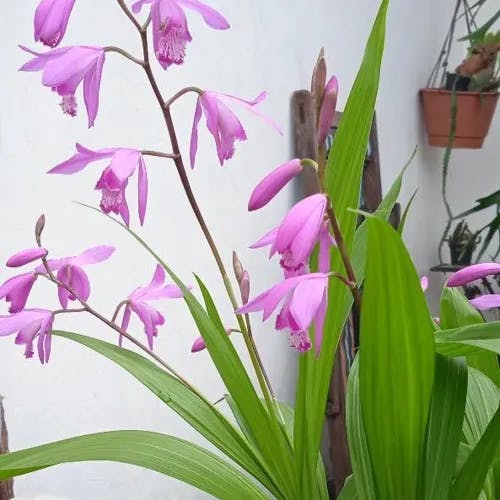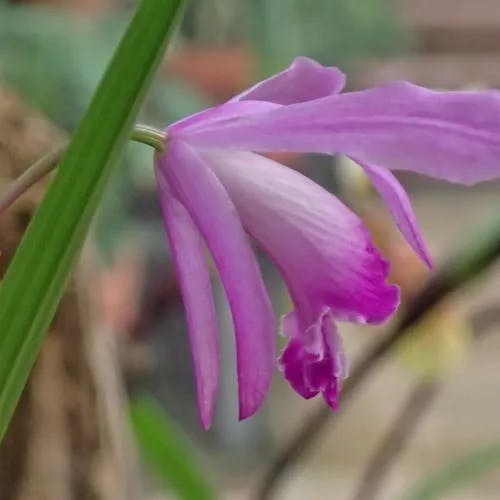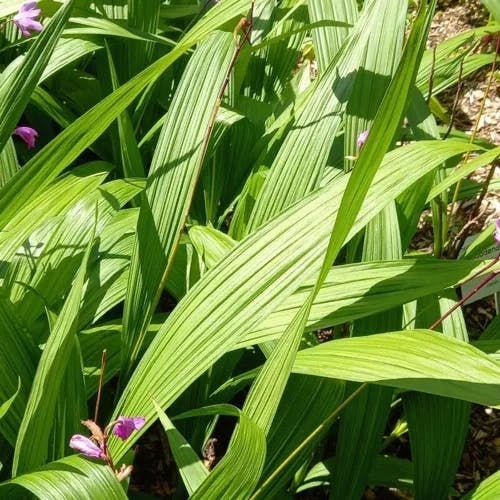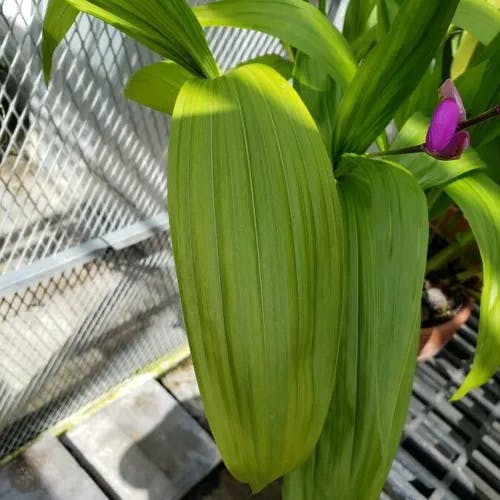Bletilla striata, commonly known as Chinese ground orchid, is a perennial herbaceous plant belonging to the Orchidaceae family. It is native to East Asia, particularly China, Japan, and Korea. The plant is characterized by its pseudobulbs, which are underground bulb-like stems. These pseudobulbs give rise to pleated leaves and a raceme of up to 14 striking flowers. The flowers of Bletilla striata are typically purple, but can also be found in white and pink varieties. They are about 2.5 cm in diameter and have a delicate, intricate structure typical of orchids. The plant produces a capsule fruit containing numerous tiny seeds. The size of the plant can vary, but it typically reaches a height of 30-60 cm. Bletilla striata is a hardy plant, making it relatively easy to grow. It prefers well-drained soil and partial shade, but can tolerate a range of conditions. In terms of symbolism, the Chinese ground orchid is often associated with refinement and beauty. It is also used in traditional Chinese medicine for its purported healing properties. There are several varieties of Bletilla striata, including 'Alba', which has white flowers, and 'Kuchibeni', which has pink flowers with a white lip. Each variety has its own unique characteristics, but all share the same basic structure and growth habits. In conclusion, Bletilla striata is a versatile and beautiful plant that is well-suited to a variety of garden settings. Its striking flowers and hardy nature make it a popular choice among gardeners and plant enthusiasts.
Chinese ground orchid
- Scientific name
- Bletilla striata
Basic Information
- Orchidaceae Family Bletilla Genus Chinese ground orchid Species
- Orchidaceae > Bletilla > Bletilla striata
- 83%
- The Completeness of This Encyclopedia
Please help us complete the encyclopedia, Terrarium is a encyclopedia service to be completed with everyone in the world. Currently, this page is 83% complete. For more information on how to contribute, please click here.
- Flower
- Forb/herb
- Perennial
- Height
- 30cm ~ 60cm
- Flower Color
- Leaf Color
- Anthesis
- spring
- Sunlight Exposure
Full Sun Long hours of sunlight from morning to afternoon Partial Shade A location in the shade of a tree or where either the morning or afternoon is shaded Full Shade A place where there is no direct sunlight
- Hardiness Zones
This is an indicator to know to which zone each plant can winter. Knowing the zone of each plant gives you an idea of the cold temperature resistance when grown in the ground without a roof. 2: -42.7 to -40.0 3: -39.9 to -34.4 4: -34.3 to -28.9 5: -28.8 to -23.3 6: -23.2 to -17.8 7: -17.7 to -12.2 8: -12.1 to -6.7 9: -6.6 to -1.1 10: -1.0 to 4.4 11: 4.5 to 10.0
- 6-9
- Cold resistance
- Good
- Heat resistance
- Fair
- Habitat of origin
- China, Japan
- Growth Rate
- Normal
What is Chinese ground orchid (Bletilla striata)?
What is Chinese ground orchid (Bletilla striata)
Flower meaning
Bletilla striata, commonly known as the Chinese ground orchid, carries a flower language that symbolizes "eloquence" in American culture. This interpretation is derived from the orchid's intricate and delicate structure, which is often associated with the art of eloquent speech. For instance, the orchid's ability to communicate its beauty without uttering a word is likened to the skill of expressing oneself effectively and persuasively. However, it's important to note that the language of flowers is largely symbolic and subjective, and interpretations can vary. As for its status as a birth flower, Bletilla striata is not recognized as a birth flower in American culture. Therefore, it does not have a specific month or date associated with it. In conclusion, while the Chinese ground orchid may not have a birth date, its flower language of "eloquence" holds a unique significance in American culture.
Calendar of Chinese ground orchid (Bletilla striata)
Calendar
Bletilla striata, also known as Chinese ground orchid, typically begins its flowering period in late spring to early summer in the United States. The peak blooming time usually occurs in May and June, when the plant's vibrant purple flowers are at their most striking. The blooming period can last for several weeks, depending on the growing conditions. To extend the flowering time, it is recommended to provide the plant with a well-drained soil, partial shade, and regular watering. Avoid overwatering as this can lead to root rot, which can shorten the blooming period. Also, deadheading spent flowers can encourage the plant to produce more blooms. Please note that Bletilla striata is a hardy plant and can tolerate a range of conditions, but it will bloom best with proper care and attention.
How to grow Chinese ground orchid (Bletilla striata)
Watering
Bletilla striata, also known as the Chinese ground orchid, requires careful watering to thrive. During the growing season, from spring to early fall, water the plant thoroughly once the top inch of soil has dried out. This usually equates to watering once or twice a week, depending on local climate conditions. In the dormant winter months, reduce watering to once every two weeks. The goal is to keep the soil consistently moist but not waterlogged. Overwatering can lead to root rot, a common issue with orchids. When watering, use a gentle stream to avoid disturbing the plant's roots. It's also beneficial to occasionally mist the plant with water to increase humidity, as Bletilla striata prefers a humid environment. Remember, the exact watering frequency may vary based on factors such as pot size, soil type, and indoor versus outdoor growth.
Soil and Fertilizer
Bletilla striata, also known as Chinese ground orchid, prefers well-drained soil rich in organic matter. The soil pH should be slightly acidic to neutral, ranging from 6.1 to 7.5. This orchid species is not a heavy feeder, so over-fertilization should be avoided. A balanced, water-soluble fertilizer (20-20-20) can be applied once a month during the growing season, from spring to early fall. The fertilizer should be diluted to half the strength recommended on the package. In winter, when the plant is dormant, no fertilizer is needed. The soil should be kept moist but not waterlogged, as this can lead to root rot. Good soil quality is crucial for the healthy growth of Bletilla striata, so regular addition of compost or well-rotted manure can be beneficial. Remember, the key to successful cultivation of this orchid is moderation in watering and fertilizing.
Sunlight and Place
Bletilla striata, also known as the Chinese ground orchid, is a hardy plant that can tolerate a wide range of sunlight exposure. It thrives best in partial shade to full sun, with optimum sunlight exposure of 4 to 6 hours per day. However, in areas with intense summer heat, it is advisable to provide some afternoon shade to prevent leaf scorch. Bletilla striata is cold hardy and can withstand temperatures down to -20 degrees Fahrenheit. During winter, it is recommended to mulch the plant to protect it from extreme cold. In terms of heat tolerance, it can survive in temperatures up to 90 degrees Fahrenheit, but it prefers cooler conditions. The plant should be placed in a location where it can receive morning sun and afternoon shade for optimal growth. Despite its strength in sunlight, it is important to monitor the plant for signs of sunburn, especially during the peak summer months.
Advanced Information of Chinese ground orchid (Bletilla striata)
Pruning
Bletilla striata, also known as Chinese ground orchid, requires minimal pruning. The main purpose of pruning is to remove dead or diseased parts of the plant, promoting overall health and encouraging new growth. The best time to prune Bletilla striata is in late winter or early spring, before new growth begins. To prune, use a sharp, sterilized tool to cut back any dead or yellowing leaves at the base of the plant. After pruning, ensure the plant is well-watered and fertilized to support new growth. Avoid over-pruning as this can stress the plant and potentially inhibit growth. Remember, Bletilla striata is a hardy plant that generally requires little maintenance, so excessive pruning is not necessary. Always monitor the plant's health and adjust care as needed.
Planting and Harvest
Bletilla striata, also known as Chinese ground orchid, is a hardy terrestrial orchid that can be grown both in-ground and in pots. For potted plants, choose a pot with good drainage and use a well-draining orchid mix. Plant the pseudobulbs 1 inch deep, with the growth point facing upwards. Water thoroughly after planting, then allow the top inch of soil to dry out before watering again. Bletilla striata prefers bright, indirect light and temperatures between 55-75°F. For repotting, do so in the spring, before new growth starts. Carefully remove the plant from its pot, gently separate the pseudobulbs, and repot using fresh orchid mix. Mishowing, or incorrect display, can be avoided by positioning the plant in a location with appropriate light and temperature, and by maintaining proper watering practices. Remember, overwatering is a common cause of mishowing in Bletilla striata.
Propagation
Bletilla striata, also known as Chinese ground orchid, is best propagated through division or seed sowing. For division, it's best done in early spring before new growth starts. Carefully separate the pseudobulbs, ensuring each division has at least one pseudobulb. Replant immediately in a well-draining orchid mix, maintaining the same planting depth. Seed sowing is more complex and requires sterile conditions. Sow seeds on the surface of a specialized orchid medium, then place in a sealed container under lights. Germination can take several months and seedlings are slow to mature. Regardless of the method, Bletilla striata prefers a sunny to partially shaded location with well-drained soil. It's hardy and can tolerate colder temperatures once established. Remember, propagation from seeds may not produce plants identical to the parent, while division will. Choose the method that best suits your needs.
Pests and Diseases
Bletilla striata, also known as Chinese ground orchid, is generally a hardy plant. However, it can be susceptible to certain pests and diseases. One of the most common pests that affect Bletilla striata is the aphid. Aphids are small, soft-bodied insects that feed on plant sap, causing the leaves to curl and yellow. To prevent aphid infestations, it is recommended to regularly inspect the plant and use insecticidal soap or neem oil if aphids are detected. Bletilla striata can also be affected by slugs and snails. These pests feed on the leaves and flowers of the plant, causing visible damage. To prevent slug and snail infestations, it is advisable to remove any potential hiding places, such as piles of leaves or debris, and to use slug and snail baits or traps. In terms of diseases, Bletilla striata can be susceptible to root rot, which is often caused by overwatering or poor drainage. Root rot can cause the plant to wilt and eventually die. To prevent root rot, it is important to ensure that the plant is not overwatered and that it is planted in well-draining soil. Another disease that can affect Bletilla striata is leaf spot, which is caused by a fungus. Leaf spot can cause brown or black spots on the leaves of the plant. To prevent leaf spot, it is recommended to avoid overhead watering and to remove and dispose of any infected leaves. In conclusion, while Bletilla striata is a generally hardy plant, it can be susceptible to certain pests and diseases. Regular inspection and appropriate preventative measures can help to keep the plant healthy.
Habitat of Chinese ground orchid (Bletilla striata)
Habitat
Toxicity of Chinese ground orchid (Bletilla striata)
Health Benefits
- edible
- Inedible
- Toxic
- No toxicity
NO DATA
Toxic for dogs and cats
NO DATA
Q&A of Chinese ground orchid (Bletilla striata)
- Pruning techniques for Japanese Andromeda
Trimming Japanese Andromeda, scientifically designated as Pieris japonica, necessitates a cautious and strategic approach. The most suitable time to prune this plant is early spring, right after its flowering phase concludes. Commence by eliminating any deceased or ailing branches to enhance the plant's overall well-being. Subsequently, trim back excessively lengthy branches to uphold the desired shape and dimensions of the shrub. It is crucial to bear in mind that Japanese Andromeda produces blooms on old wood, signifying that the buds for the following year's flowers develop during the ongoing growing season. Consequently, refrain from substantial pruning in late summer or autumn, as this could potentially excise these buds and diminish the following year's blossom. Conversely, when it comes to the Chinese ground orchid, or Bletilla striata, it necessitates an alternative pruning method. This plant, a robust terrestrial orchid, typically does not demand extensive pruning. Merely eliminate the spent flower spikes following blooming and any leaves that exhibit yellowing or browning. Remember, each plant possesses its own distinctive pruning prerequisites contingent on its growth pattern and blooming cycle. Always ensure the utilization of clean, sharp tools to achieve precise cuts and mitigate the risk of disease transmission.
0
0
- Protecting Japanese Pieris from deer
To safeguard Japanese Pieris, also referred to as Pieris japonica, from deer, it is recommended to utilize deer deterrents or physical impediments. Deer deterrents can take the form of either odor-based or taste-based repellents, effectively discouraging deer from foraging on the plants. Nevertheless, these repellents necessitate frequent reapplication, particularly after rainfall. Physical impediments such as deer fencing or netting can also prove to be efficacious. They serve as barriers that prevent deer from accessing the plants, thereby shielding them from harm. It is essential to acknowledge that the efficacy of these approaches may fluctuate contingent upon the local deer population and their feeding patterns. Consequently, a combination of methods may be requisite for optimal protection. Concerning the Chinese ground orchid, Bletilla striata, it is not inherently alluring to deer, and thus, it may not demand the same extent of protection as Japanese Pieris. Nevertheless, if deer pose a concern in your vicinity, employing the same methods can be employed to shield these orchids as well.
- What is Mountain Fire Pieris in the Garden?
Pieris japonica 'Mountain Fire,' commonly referred to as Mountain Fire Pieris, is a highly sought-after ornamental shrub frequently found in gardens. Its claim to fame lies in its strikingly red young leaves that burst forth during the spring, reminiscent of a fiery mountain landscape, thus giving it its distinctive name. It's crucial not to conflate this shrub with the Chinese ground orchid, Bletilla striata, as they belong to entirely separate species. The Chinese ground orchid is a robust terrestrial orchid originating from East Asia, celebrated for its exquisite purple-pink blossoms. While both of these plants have the potential to bring a touch of visual allure to a garden, their care requisites and growth patterns differ significantly. As a result, comprehending their distinct necessities is paramount to ensure their thriving and vitality.
- Is there a recommended way to choose Bletilla striata?
Bletilla striata, also referred to as Chinese ground orchid, is a resilient terrestrial orchid. When selecting seedlings, seek out robust, healthy plants adorned with firm, green leaves, and devoid of any indications of illness or infestation. In the case of seed acquisition, ensure their freshness, as older seeds tend to exhibit reduced germination rates. For those desiring a garden with a more understated and elegant appearance, Bletilla striata 'Alba,' boasting white blossoms, may be the ideal choice. If you aspire to create a more striking and dramatic visual impact, consider Bletilla striata 'Big Bob,' known for its larger and more flamboyant flowers. For a vibrant infusion of color, explore Bletilla striata 'Kuchibeni,' which showcases pink flowers with a red lip. It's important to note that while each variety shares fundamental care requirements, their aesthetic allure differs. Select the one that aligns with your personal preferences and complements your garden's design.
- Can we raise Andromeda in Japan?
Yes, it is indeed possible to cultivate Andromeda, also recognized as Pieris japonica, within Japan. This botanical specimen is indigenous to eastern Asia, including Japan, and it thrives harmoniously within the nation's temperate climate. It is, however, vital to distinguish Andromeda from the Chinese ground orchid, scientifically identified as Bletilla striata. The Chinese ground orchid constitutes a distinct species that also flourishes within Japan, yet it demands marginally distinct nurturing and environmental conditions when juxtaposed with Andromeda. Both of these plants constitute splendid augmentations to any garden and can be triumphantly nurtured with the appropriate care and vigilant attention.
0
0
